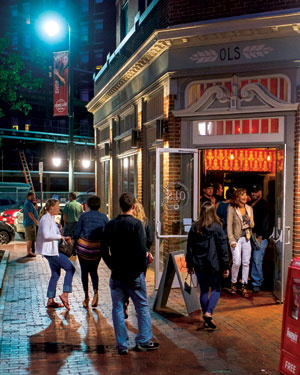July/August 2016 | view this story as a .pdf
The rise and rise of Longfellow Square.
By Dan Kany
Because Portland is a port, it is a tidal city. And what are tides, if not currents that ebb and flow? Over the years we’ve watched as Congress Street has gone boom and bust and back again. Art venues seem to blossom in herds before they become unheard. But new venues take seed and over time, despite the roughness of the rhythms, it is clear that Maine’s first city is a truly fertile ground. Because of this, we sometimes see emptied spaces not as shuttered failures but as fallow fields.
And that is why, when I see the empty space of “The Frame Shop” on State Street, I see another foothold for upward ascent. While the neighborhood is anchored with some reliably fixed points, its open spaces have consistently made the area at the edge of the arts district hipper, friendlier, and better. A recent request for a re-zoning permit tells us the former shop may be transformed into a restaurant. Word on the grapevine? The Otto empire is looking to expand.
Just a few doors down, the papered-up windows of Petite Jacqueline will soon house the pizza chain’s sister venture, Ocho Burrito, currently operating out of a tiny carry-out space on Congress Street. It seems Longfellow Square has been selected as the new headquarters for this unstoppable food power-couple. On paper, trading a French restaurant for a burrito joint might seem a southward stumble, but I doubt anyone who has tried the deliriously delicious Ocho or Otto would agree. With tidal logic, the notion of “trendy” can imply a fleeting fancy, without rooted staying power. But Portland is not some capricious teenager of a town. It has long been an arts city and once it ascended the ranks of America’s gastronomical stars, it was clear there would never be any going back.
Take a glance around town at the city’s perennial favorites, and you’ll see Portland’s success model is all about keeping it simple and doing what you do better than anyone expects. As Longfellow himself once said, “The talent of success is nothing more than doing what you can do well and doing well whatever you do without thought of fame.” This is the logic behind the craft beer movement, the farm-to-table movement, the Maine art scene, and favorite local fixed points like Beal’s (ice cream), DuckFat (fries), and Nosh (burgers). Take a Longfellow staple. Pai Men Miyake doesn’t pretend to make authentic Japanese-style ramen, which is artfully subtle and infinitely light. Instead, try their paitan ramen, unapologetically rich and indulgent. If you want a level field comparison, try their Brussels sprouts–every normal kid’s anathema, right? Deep-fried to a crispy perfection and then dressed with a flavor explosion led by fish sauce and mint, these Brussels sprouts transcend expectation.
The square is anchored by Franklin Simmons’ heroically scaled Henry Wadsworth Longfellow Monument, unveiled in 1888. While seated in an ornate indoor armchair with lion-carved armrests, Maine’s most famous poet is depicted wearing an overcoat, a quirk that seems to invite Longfellow’s annual holiday adornments of scarves, wrapped presents, and so on.
The square’s literary flavor is quietly held intact by LFK, a bar that occupies the old Cunningham Books shop. Within, books and old typewriters abound among the dark wood spaces. True to local spirit, the craft beer choices are impressively deep, and the food surpasses expectations, whether standards like mac and cheese and burgers or hearty and creative vegetarian fare.
Across Congress Street, the vast hole where Joe’s Smoke Shop used to be is rising toward its new life as an eight-story apartment building. This will only increase the happening bustle in and around the square. The 70-year-old Joe’s, moreover, is being resurrected in the new building as Joe’s Super Variety.
Featuring several thriving design and antiques stores and a pair of hipster-styled coffee shops, the West End side of Congress Street just off Longfellow Square is flourishing as well.
While the noted and popular restaurants like Local 188 (tapas and paella), Boda (contemporary Thai), King of the Roll (Japanese), Hot Suppa (hearty Southern cafe fare) comprise a major draw, the actively beating heart of the neighborhood is One Longfellow Square, a non-profit 225-seat performance venue that varies its offerings between acoustic music, jazz, film, dance, contemporary music, and comedy. Just as OLS sits on the Arts District corner of Longfellow Square, its community-oriented artiness knits it to Portland’s deep vein of casually dressed and yet mindfully creative culture.
Is Longfellow Square in danger of becoming overrun with trendy pretenders? I wouldn’t bet on it. I don’t think the Treasure Chest, that wizened shop of naughtiness, or the dive-y and unpretentious Blackstones are going anywhere anytime soon. I rather think the neighborhood is more like Longfellow himself, the old Bowdoin professor who not only gave us popular poems like the “Song of Hiawatha” and “The Midnight Ride of Paul Revere,” but who was also the first American to translate Dante’s Divine Comedy. The neighborhood itself seems to be reflecting the spirit of Longfellow’s savvy advice: “Build today, then strong and sure, With a firm and ample base; And ascending and secure. Shall tomorrow find its place.”






0 Comments